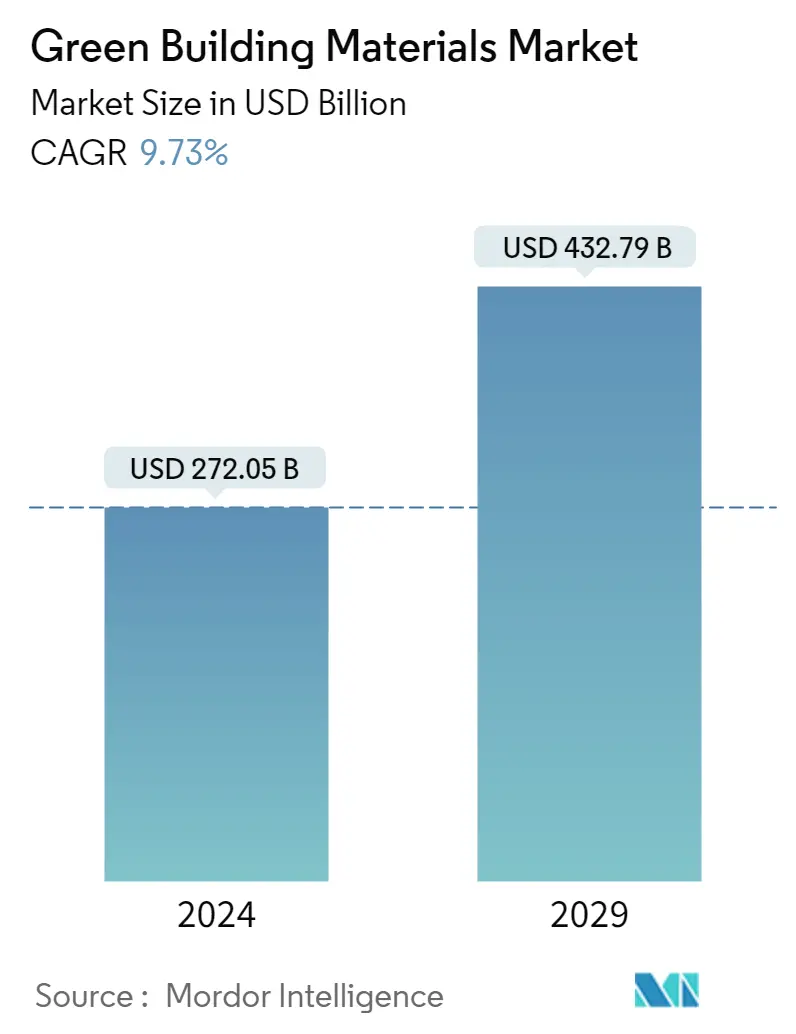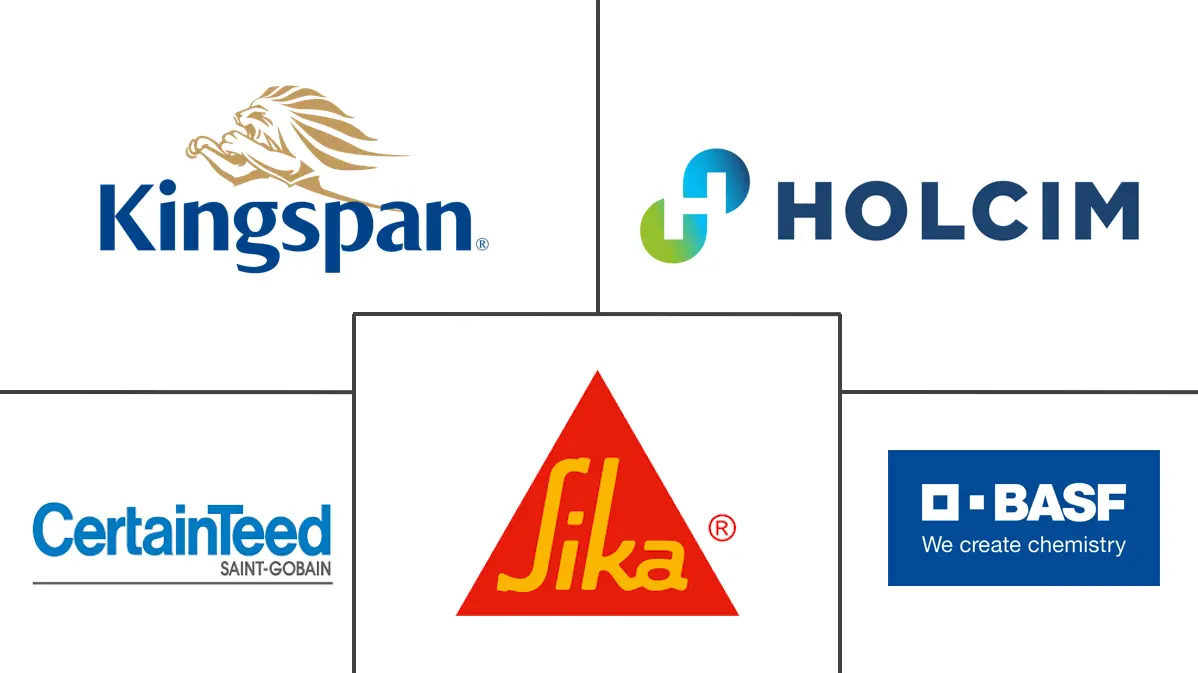Market Size of Green Building Materials Industry

| Study Period | 2019 - 2029 |
| Market Size (2024) | USD 272.05 Billion |
| Market Size (2029) | USD 432.79 Billion |
| CAGR (2024 - 2029) | 9.73 % |
| Fastest Growing Market | Asia-Pacific |
| Largest Market | North America |
Major Players
*Disclaimer: Major Players sorted in no particular order |
Green Building Materials Market Analysis
The Green Building Materials Market size is estimated at USD 272.05 billion in 2024, and is expected to reach USD 432.79 billion by 2029, growing at a CAGR of 9.73% during the forecast period (2024-2029).
The outbreak of COVID-19 in 2020 and the first half of 2021 significantly affected the global construction sector due to government-imposed bans and restrictions, thereby limiting the growth of the green building materials market. Residential real estate was the worst hit as strict lockdown measures across major cities resulted in the suspension of home registrations and slow disbursements of home loans. However, the sector has been recovering well since these restrictions were lifted. An increase in house sales, new project launches, and an increasing demand for new offices and commercial spaces have been leading the market recovery over the last two years.
- Over the medium term, the potential application of green building materials in energy-efficient buildings is the major driving factor driving the growth of the market studied. Furthermore, there are favorable government policies that support green building construction and ensure standard practices across all construction sectors. These policies are prompting the manufacturers of construction materials to include more green material compositions/systems in their products.
- On the flip side, the high first capital investments for green building construction when compared to conventional buildings is the key factor anticipated to restrain the growth of the market studied over the forecast period.
- Nevertheless, the increasing focus of various economies on achieving carbon neutrality, the declining operation costs of green buildings over time, and the growing trends in recycled construction are likely to create lucrative growth opportunities for the global market soon.
- North America is expected to dominate the market during the forecast period. This dominance is attributed to the high demand for framing, roofing, insulation, and various other applications in the residential, commercial, industrial, and infrastructure sectors.
Green Building Materials Industry Segmentation
Green building materials are defined as materials that are non-toxic, environment-friendly, and sustainable, leading to improved occupancy health, lowered energy cost, and reduced energy consumption. The operating costs of green buildings are lower than that of regular buildings, with 63% lower water usage and 53% lower electricity usage.
The green building materials market is segmented by application, end-user industry, and geography. By application, the market is segmented into framing, insulation roofing, exterior siding, interior finishing, and other applications. By end-user industry, the market is segmented into residential, commercial, industrial and institutional, and infrastructure. The report also covers the market size and forecasts for the green building materials market in 15 countries across major regions. For each segment, the market sizing and forecasts have been done based on revenue (USD million).
| Application | |
| Framing | |
| Insulation | |
| Roofing | |
| Exterior Siding | |
| Interior Finishing | |
| Other Applications |
| End-use Industry | |
| Residential | |
| Commercial | |
| Industrial and Institutional | |
| Infrastructure |
| Geography | |||||||
| |||||||
| |||||||
| |||||||
| |||||||
|
Green Building Materials Market Size Summary
The green building materials market is poised for significant growth, driven by the increasing application of these materials in energy-efficient buildings and supportive government policies. The market, which experienced setbacks due to the COVID-19 pandemic, has been recovering as demand for residential and commercial spaces rises. The residential sector, in particular, is a major end-user, with materials like fiber cement siding, bamboo, and recycled plastics gaining traction due to their energy efficiency and durability. Government incentives in various countries, such as tax credits and subsidies, are further promoting the adoption of green building materials, contributing to the market's expansion.
North America is expected to lead the market, supported by high consumption levels across various construction activities and robust government initiatives aimed at reducing greenhouse gas emissions. The LEED rating system in the United States and similar programs in Canada and Mexico are pivotal in driving the market forward. The global market remains fragmented, with key players like Sika AG, Kingspan Group, and Holcim actively expanding their presence through strategic acquisitions. These developments, coupled with the growing focus on carbon neutrality and recycled construction, are anticipated to create lucrative opportunities for the green building materials market in the coming years.
Green Building Materials Market Size - Table of Contents
-
1. MARKET DYNAMICS
-
1.1 Drivers
-
1.1.1 Increasing Demand for Insulation and Energy-efficient Buildings
-
1.1.2 Favorable Government Policies for Green Buildings
-
-
1.2 Restraints
-
1.2.1 High Initial Capital Investment Compared to Conventional Buildings
-
-
1.3 Industry Value-Chain Analysis
-
1.4 Porter's Five Forces Analysis
-
1.4.1 Bargaining Power of Suppliers
-
1.4.2 Bargaining Power of Buyers
-
1.4.3 Threat of New Entrants
-
1.4.4 Threat of Substitute Products and Services
-
1.4.5 Degree of Competition
-
-
-
2. MARKET SEGMENTATION (Market Size in Value)
-
2.1 Application
-
2.1.1 Framing
-
2.1.2 Insulation
-
2.1.3 Roofing
-
2.1.4 Exterior Siding
-
2.1.5 Interior Finishing
-
2.1.6 Other Applications
-
-
2.2 End-use Industry
-
2.2.1 Residential
-
2.2.2 Commercial
-
2.2.3 Industrial and Institutional
-
2.2.4 Infrastructure
-
-
2.3 Geography
-
2.3.1 Asia-Pacific
-
2.3.1.1 China
-
2.3.1.2 India
-
2.3.1.3 Japan
-
2.3.1.4 South Korea
-
2.3.1.5 Rest of Asia-Pacific
-
-
2.3.2 North America
-
2.3.2.1 United States
-
2.3.2.2 Canada
-
2.3.2.3 Mexico
-
-
2.3.3 Europe
-
2.3.3.1 Germany
-
2.3.3.2 United Kingdom
-
2.3.3.3 Italy
-
2.3.3.4 France
-
2.3.3.5 Rest of Europe
-
-
2.3.4 South America
-
2.3.4.1 Brazil
-
2.3.4.2 Argentina
-
2.3.4.3 Rest of South America
-
-
2.3.5 Middle East & Africa
-
2.3.5.1 Saudi Arabia
-
2.3.5.2 South Africa
-
2.3.5.3 Rest of Middle East & Africa
-
-
-
Green Building Materials Market Size FAQs
How big is the Green Building Materials Market?
The Green Building Materials Market size is expected to reach USD 272.05 billion in 2024 and grow at a CAGR of 9.73% to reach USD 432.79 billion by 2029.
What is the current Green Building Materials Market size?
In 2024, the Green Building Materials Market size is expected to reach USD 272.05 billion.

